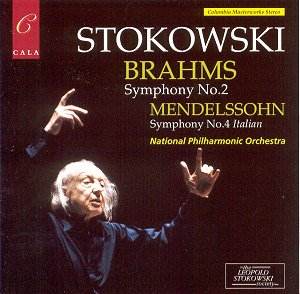Recorded in 1977 shortly before Stokowski’s death these
performances have a linear cogency and articulacy of expression that
are little short of remarkable and would be so in any conductor, of
any age, at any time, much less one of ninety five. It’s tempting to
conjure up the alchemical or the visionary to try to explain Stokowski’s
unerring rightness but that is to ignore the obvious evidence of sheer
hard work, adroit musical understanding, advanced ear for orchestral
sonorities and a lifetime’s experience.
In fact, oddly, Mendelssohn was not a composer who
much features in Stokowski’s recorded legacy nor, it has to be said,
in his concert programmes. His first conducted the Italian in
1914 in Philadelphia, again in 1917, and this seems to have been the
last performance until this 1977 studio recording, a really rather remarkable
lacuna. His effortless launching of the Allegro Vivace at a tempo
guisto (if you know Cantelli’s live broadcast performance you’ll think
it’s a different work) is supremely effective. The string and woodwind
choirs are adroitly balanced and for all that this is big band Mendelssohn
it is flexible, responsive and superbly mobile music making. The final
passages of the first movement are marked by clarity and precision and
the control of dynamics in the development section earlier is entirely
admirable. Precise articulation and a strongly lyrical impulse inform
the slow movement; the balancing is well nigh perfect. The Minuet and
trio - the Moderato – features nicely judged layered string writing,
and not too much heft in the basses. The Saltarello is invigoratingly
alive, a minor key dance of life to which Stokowski responds with tremendous
brio.
The Brahms Second Symphony is obviously more a staple
of his repertoire. His was, after all, the first American-recorded set
of the complete Brahms Symphonies. First performed by Stokowski in Cincinnati
in 1912 he’d recorded it in Philadelphia in 1929. As his later Brahms
often reveals, clarity and architectural cogency allied to a strong
sense of momentum had become hallmarks of Stokowski’s approach. There
is a palpable sense of linearity supported by entirely appropriate instrumental
weight throughout. The clarinet counterpoint to the string theme in
the first movement or the beautifully accomplished entwining melody
at 6.30 or the well judged trumpet balancing at 8.40 – never forced,
never over bright, never submerged textually – are small, telling and
revealing incidents of magisterial control. Listen to the exemplary
pizzicatos in the second movement or to its melodic unravelling, the
non troppo marking properly observed or indeed to the sensitivity
of the National Philharmonic Orchestra, an ad hoc London group of stellar
accomplishment. This is a truly remarkable document of an ever-questing
musician - first movement exposition repeats taken in both works by
the way – whose final recordings are as noble, as understanding and
as true as one could ever wish to hear.
Jonathan Woolf


